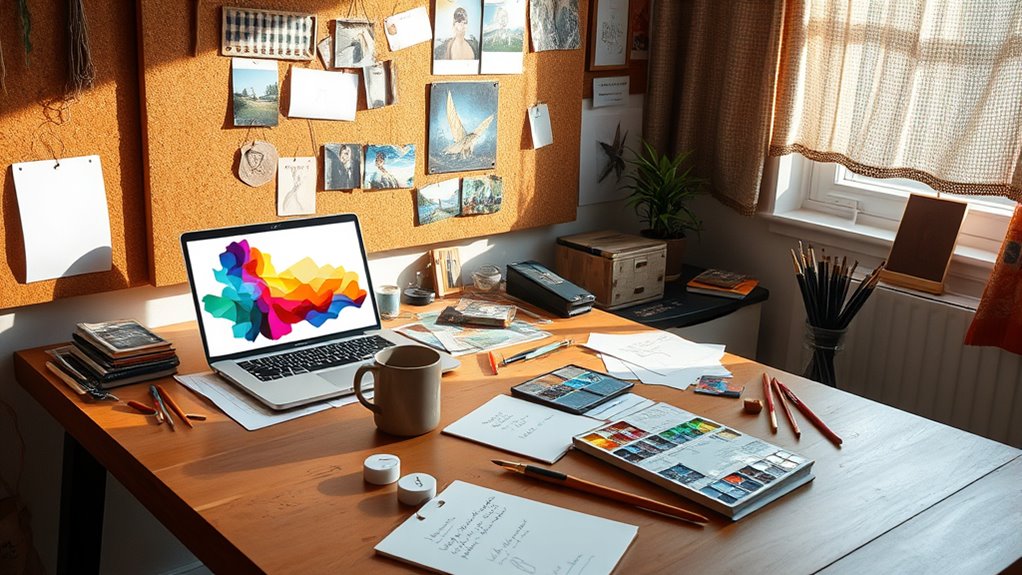To build an artist statement that resonates, focus on sharing your unique creative voice by weaving together your stories, inspirations, and techniques into a compelling narrative. Be honest and vivid, highlighting what motivates you and how you approach your work. Use clear language that invites connection while balancing intrigue. If you stay authentic and purposeful, your statement will effectively showcase your artistry and invite viewers to see your work through your eyes. Keep going to explore these ideas more deeply.
Key Takeaways
- Clearly articulate your core themes, motivations, and artistic vision to establish genuine connection.
- Use vivid, descriptive language to evoke scenes, emotions, and conceptual insights.
- Incorporate personal stories and influences to add authenticity and unique perspective.
- Balance clarity with intrigue, leaving room for interpretation to engage viewers.
- Maintain a consistent tone that reflects your creative voice and overall artistic identity.

Have you ever wondered how to effectively communicate your artistic vision? Crafting an artist statement is your chance to share what drives you, what inspires your work, and how you see the world through your art. Your statement should serve as a window into your creative process, giving viewers insight into your intent and meaning. To do this well, focus on developing a strong visual storytelling element within your narrative. Visual storytelling isn’t just about what you create; it’s about how you tell your story through your art. Your statement should weave together the themes, symbols, and motifs that define your work, making it easier for others to understand and connect with your artistic message.
A key part of building an effective artist statement is cultivating your creative voice. This voice reflects your unique perspective, personality, and approach to art. It’s what distinguishes you from others and makes your work memorable. When writing, avoid overly technical jargon or generic descriptions. Instead, speak honestly about what motivates you, what challenges you face, and what you hope viewers take away. Your creative voice should be authentic and compelling, giving readers a sense of who you are as an artist. It’s okay to show vulnerability or passion—these qualities resonate and make your statement more relatable.
When constructing your statement, start by pinpointing the core ideas behind your work. Think about what stories you want to tell and why they matter to you. Use vivid language that captures the essence of your visual storytelling, allowing readers to imagine the scenes, emotions, or concepts you explore. Be specific about your influences, techniques, or themes, but also leave room for interpretation. Your goal is to invite curiosity, not to spell everything out explicitly. Keep your tone consistent with your creative voice, whether it’s poetic, direct, or introspective. Additionally, understanding the importance of resources and tools like local legal resources and support systems can help you navigate the sometimes complex process of presenting and promoting your art.
Frequently Asked Questions
How Do I Make My Artist Statement Stand Out?
To make your artist statement stand out, focus on clear visual storytelling that highlights your unique perspective. Use compelling language to create emotional resonance, helping viewers connect with your work on a deeper level. Share specific experiences or inspirations that shaped your art, and keep your tone authentic. By engaging your audience emotionally and visually, your statement will leave a lasting impression and truly reflect your artistic voice.
Should I Include Personal Stories in My Statement?
Imagine your artist statement as a window into your world. Including personal anecdotes and emotional storytelling helps viewers see your passion and connect deeply. You should share a brief, meaningful story that highlights your journey or inspiration, making your work more relatable and vivid. Personal stories add authenticity and warmth, inviting others to see the heart behind your art without overwhelming the main message.
How Long Should My Artist Statement Be?
You should aim for an artist statement that’s around one page, roughly 300-500 words. This length helps you attain artistic clarity and guarantees your message is clear without overloading your audience. Keep your language concise and focused, avoiding unnecessary details. Remember, your goal is to communicate your ideas effectively, so prioritize quality over quantity and make every word count for a statement that truly resonates.
When Is the Best Time to Update My Statement?
You should update your artist statement based on timing considerations like significant changes in your work or career milestones. Regular updating frequency helps keep it current and relevant, so consider revisiting it annually or whenever your artistic focus shifts. This ensures your statement accurately reflects your evolving style and goals, making it more impactful for exhibitions, grants, or networking. Don’t wait too long—timely updates keep your narrative fresh.
How Can I Tailor My Statement for Different Audiences?
Thinking about how to tailor your statement for different audiences, you see, it’s all about subtle shifts. You conduct audience analysis to understand their interests and expectations, then adapt your tone accordingly. By emphasizing relevant themes and adjusting your language, you connect more deeply. This approach guarantees your message resonates, no matter who’s reading, making your artist statement versatile and engaging across diverse groups.
Conclusion
By crafting an artist statement that truly resonates, you open a door to a universe where your art breathes and shouts your soul’s story. It’s like igniting a wildfire that spreads across minds, lighting up every corner of the gallery with your passion. When your words echo your vision, they become a magnet pulling viewers into your world—transforming mere spectators into lifelong fans. Your statement becomes the heartbeat that makes your art impossible to ignore.









